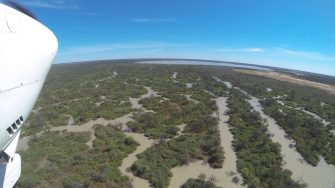
Date: Tuesday, November 15, 2016
Project: Eastern Australian Waterbird Survey
Observer: Richard Kingsford
We headed west again to count some of the Gwydir wetlands for the second time. We survey all of the major wetlands in the Murray-Darling Basin twice to get a measure of the variability of our counts. There were a few hundred waterbirds on the floodplains, similar to yesterday, including a colony of egrets.
Surveying the floodplains of the Gingham watercourse of the Gwydir River
Lagoons intersperse reedbeds on the Gwydir floodplain, supplied by environmental flow
Colony of egrets on the Gwydir floodplain
From here, we headed west again to the next of four major wetland systems to be surveyed today – Narran Lakes. From a distance we could see that the small freshwater lake in the middle of the Nature Reserve looked reasonably full although not completely. The lake had hundreds of grey teal and flocks of yellow-billed spoonbills, pelicans and migratory shorebirds.
Clear Lake in Narran Lake Nature Reserve
Surveying Clear Lake
The surprises kept coming. We have been surveying for a month and a half and nowhere have we seen waterbirds in such high densities. Large flocks of grey teal, hardhead and wood duck rose in waves in front of the plane as we zig-zagged across the floodplain where the channels were running.
Flooded channels ‘filled’ with ducks with Clear Lake in the background
Surveying the channels surrounding the Narran Lakes system
Both north and south of Clear Lake the channels leading into and away from the lake were brimming with ducks. There were thousands, including teal, hardhead, wood duck and plumed whistling-ducks. It was great to see so many ducks here where most other places they are thin on the water. I think it reflects both the arrival of the flood front – they seem to know – and the productivity of the Narran Lakes system. It is a major concern that the Northern Review of the Murray-Darling Basin plan might not deliver the environmental water for this biodiverse hotspot to continue to be so productive.
Channels splayed across the dry Narran Lake, spreading south
Surveying channels of the Narran Lakes system
Next wetland stop, via Bourke on the Darling River to refuel, was the Currawinya Lakes, Lake Numalla and Lake Wyara. We always look forward to these lakes. We had an even more heightened sense of anticipation, given the ‘rev-up’ we had experienced surveying Narran Lakes, despite all the surveying we have done. The Currawinya Lakes are special. There can be high diversity of waterbirds on these lakes in large numbers. I surveyed the lakes in the late 1980s and sometimes they supported more than a quarter of a million waterbirds. Not today.
Lake Numalla in the foreground and Lake Wyara in the background
Surveying Lake Numalla
Lake Numalla was only about half full which was also not expected. We thought the floods had been much greater out here, given water in other rivers. You just never know. Despite this, the lake had more than a thousand waterbirds including several hundred grey teal and red-necked avocets.
Red-necked avocets swirling below on Lake Numalla
Lake Wyara was about 70% full but with considerably fewer waterbirds, compared to Lake Numalla. Usually, it is the other way around with this salt lake generally having about ten times more waterbirds that Lake Numalla. About eighty percent of Wyara’s waterbirds were swans and, of these, perhaps half were broods. There were plenty of aquatic plants growing on the lake bottom, always indicative of productive swan habitat.
Surveying Lake Wyara
Our final wetland system was Yantabulla Swamp, supplied mainly by Cuttaburra Creek which gets water from the Warrego River. I thought it would be dry but was pleasantly surprised by the ‘finger’ channels spreading across the vast floodplain.
Fingers of water spreading across Yantabulla Swamp.
The channels of water across Yantabulla Swamp
There were relatively few waterbirds on the swamp, mainly because it had not had sufficient water to fill the wetland. Despite this, there was a small egret and ibis colony established on the wetland.
Egret and ibis colony in Yantabulla Swamp
Surveying Yantabulla Swamp
Tomorrow – we finish the 2016 survey in the Macquarie Marshes.
